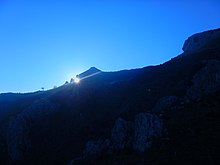Ekuinoks: Pabidaan ralatan
Kadada kasimpulan babakan |
Kadada kasimpulan babakan |
||
| Baris 7: | Baris 7: | ||
Di [[balahan Bumi bagian utara]], [[ekuinoks Maret]] dipinandui lawan ngaran titik balik musim semi, amun [[ekuinoks September]]nya dipinandui lawan ngaran titik balik musim gugur. Di [[balahan Bumi bagian salatan]] malahan kabalikannya, hal ngini kada lain dipangaruhi [[tahun kabisat]] wan faktor lainnya. |
Di [[balahan Bumi bagian utara]], [[ekuinoks Maret]] dipinandui lawan ngaran titik balik musim semi, amun [[ekuinoks September]]nya dipinandui lawan ngaran titik balik musim gugur. Di [[balahan Bumi bagian salatan]] malahan kabalikannya, hal ngini kada lain dipangaruhi [[tahun kabisat]] wan faktor lainnya. |
||
Di balamahan bumi nang tangah ngarannya '''ekuinoks mara utara'''gasan [[equinox Maret]], hal ngini manampaiakan bahwa haratan ngitu matahari malewati ekuator langit di arah mara ka utara, wan '''ekuinoks mara salatan''' gasan [[ekuinoks September]], manamapaikan bahwa haratan ngitu matahari malewati ekuator langit di arah mara ka salatan. |
|||
Hemisphere-neutral names are '''northward equinox''' for the [[March equinox]], indicating that at that moment the solar declination is crossing the celestial equator in a northward direction, and '''southward equinox''' for the [[September equinox]], indicating that at that moment the solar declination is crossing the celestial equator in a southward direction. |
|||
Mulai wayah Bulan (wan planet-planet nang tarandah) maakibatakan [[orbit Bumi]] ka [[eksentrisitas orbit]] sadikit balain matan [[orbit elips]], ekuinoks sacafa rasmi ditantuakan ulih jadwal rigulir [[sistem koordinat garhana]] matahari daripada [[deklinasi matan matahari]]. The instants of the equinoxes are currently defined to be when the apparent geocentric longitude of the Sun is 0° and 180°.<ref>{{cite book |title=Astronomical Almanac |at=Glossary |publisher=[[United States Naval Observatory]] |year=2008}}</ref> |
|||
[[File:Equinozio da Pizzo Vento,tramonto fondachelli fantina, sicilia.JPG|thumb|The Sun on the equinox as seen from the site of [[Pizzo Vento]], [[Fondachelli-Fantina]], [[Sicily]]]] |
[[File:Equinozio da Pizzo Vento,tramonto fondachelli fantina, sicilia.JPG|thumb|The Sun on the equinox as seen from the site of [[Pizzo Vento]], [[Fondachelli-Fantina]], [[Sicily]]]] |
||
Ralatan matan 19 April 2021 16.22

Ekuinoks marupakan fenomena pas ekuator langit lawan ekuator bumi malewati pusat geometris matan cakram matahari.[1][2] Fenomena ngini tajadi dua kali satiap tahunnya, yaitu, pas sakitar 20 Maret wan 23 September. Kawa disambat, bahwa kajadian ngini marupakan fenomena haratan tangah matahari kawa taitihi baandak pas di atas ekuator
Kata ekuinoks diambil matan basa Latin aequinoctium, nang baasal matan kata aequus nang artinya sama wan nox (genitif noctis) nang baisi arti malam. Pas harinya ekuinoks cungul, siang wan malam waktunya sama di sabarataan wilayah di Bumi. Tapi kada sabarataan jua sama, hal ngini maraga ukuran buncu matahari, refraksi atmosfir, wan paubahan hancap hari nang cungul di kabanyakan di garis lintang parak ekuinoks. Jauh sabalum parsamaan nang ngini ditamuakan, budaya ekuator primitif sudah mancatat hari apa haja Matahari cungul di timur wan tinggalam di barat, wan kajadian ngini dasar parak banar lawan kajadiakan nang ditantuakan sacara astronomis. Akibatnya, manurut jam matahari nang diulah wan diatur bujur-bujur, siang hari waktunya 12 jam.
Di balahan Bumi bagian utara, ekuinoks Maret dipinandui lawan ngaran titik balik musim semi, amun ekuinoks Septembernya dipinandui lawan ngaran titik balik musim gugur. Di balahan Bumi bagian salatan malahan kabalikannya, hal ngini kada lain dipangaruhi tahun kabisat wan faktor lainnya.
Di balamahan bumi nang tangah ngarannya ekuinoks mara utaragasan equinox Maret, hal ngini manampaiakan bahwa haratan ngitu matahari malewati ekuator langit di arah mara ka utara, wan ekuinoks mara salatan gasan ekuinoks September, manamapaikan bahwa haratan ngitu matahari malewati ekuator langit di arah mara ka salatan.
Mulai wayah Bulan (wan planet-planet nang tarandah) maakibatakan orbit Bumi ka eksentrisitas orbit sadikit balain matan orbit elips, ekuinoks sacafa rasmi ditantuakan ulih jadwal rigulir sistem koordinat garhana matahari daripada deklinasi matan matahari. The instants of the equinoxes are currently defined to be when the apparent geocentric longitude of the Sun is 0° and 180°.[3]

- ^ "Equinoxes". Astronomical Information Center. United States Naval Observatory. 14 June 2019. Diarsipkan dari versi asli tanggal 25 May 2019. Diakses tanggal 9 July 2019.
On the day of an equinox, the geometric center of the Sun's disk crosses the equator, and this point is above the horizon for 12 hours everywhere on the Earth. However, the Sun is not simply a geometric point. Sunrise is defined as the instant when the leading edge of the Sun's disk becomes visible on the horizon, whereas sunset is the instant when the trailing edge of the disk disappears below the horizon. These are the moments of first and last direct sunlight. At these times the center of the disk is below the horizon. Furthermore, atmospheric refraction causes the Sun's disk to appear higher in the sky than it would if the Earth had no atmosphere. Thus, in the morning the upper edge of the disk is visible for several minutes before the geometric edge of the disk reaches the horizon. Similarly, in the evening the upper edge of the disk disappears several minutes after the geometric disk has passed below the horizon. The times of sunrise and sunset in almanacs are calculated for the normal atmospheric refraction of 34 minutes of arc and a semidiameter of 16 minutes of arc for the disk. Therefore, at the tabulated time the geometric center of the Sun is actually 50 minutes of arc below a regular and unobstructed horizon for an observer on the surface of the Earth in a level region
- ^ "ESRL Global Monitoring Division - Global Radiation Group". NOAA. www.esrl.noaa.gov (dalam bahasa Inggris). U.S. Department of Commerce. Diakses tanggal 9 July 2019.
- ^ Astronomical Almanac. United States Naval Observatory. 2008. Glossary.
